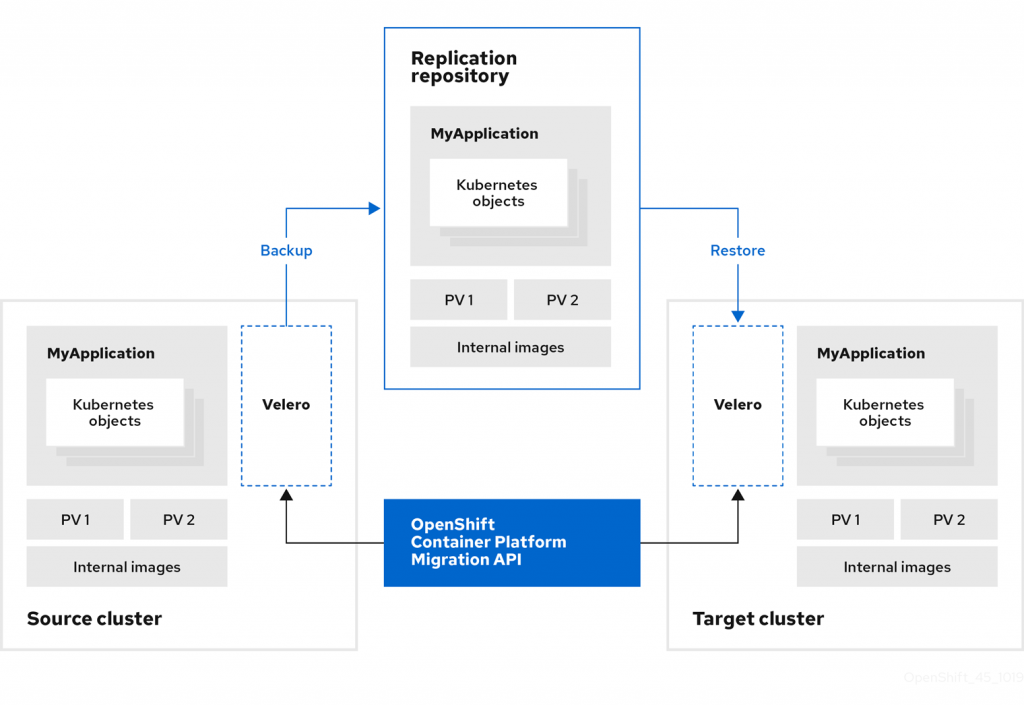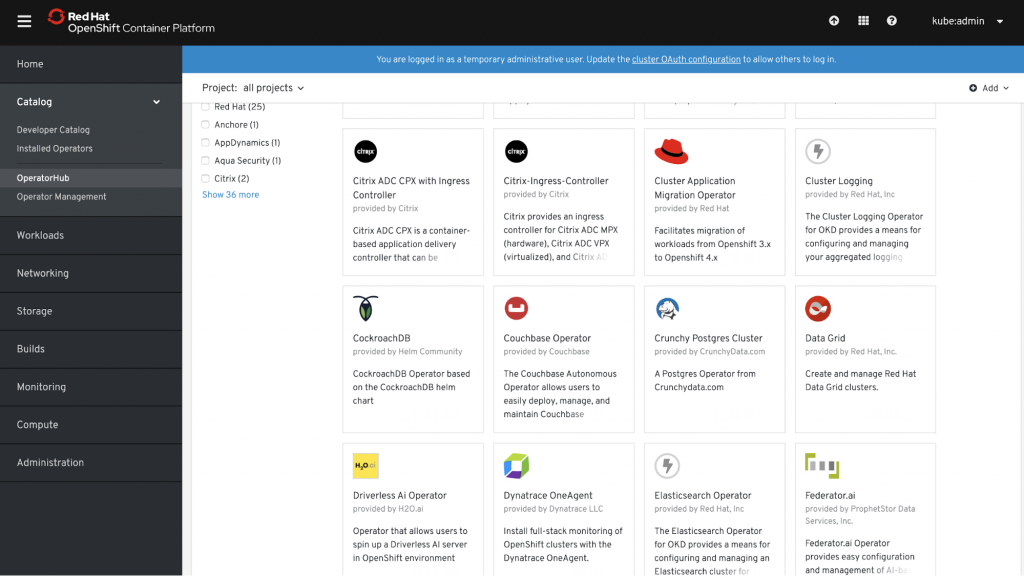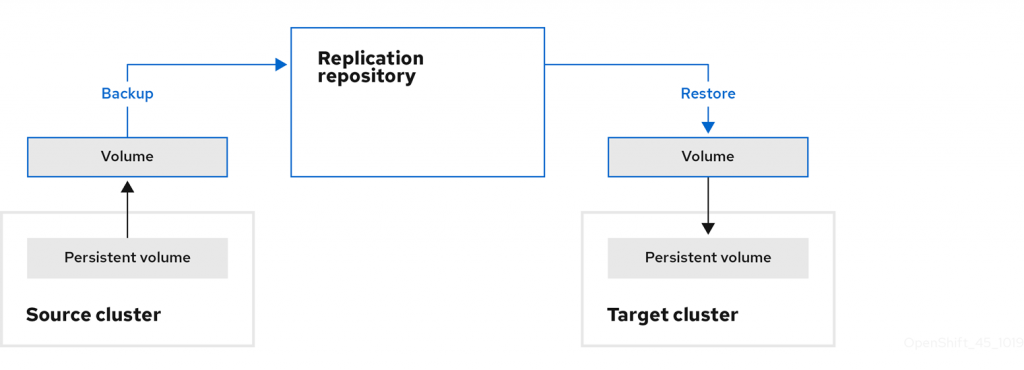If you’re looking for a path to upgrade your Red Hat OpenShift 3.7+ cluster to OpenShift 4.2, you’re in luck. The Migration Toolkit for Containers was built to migrate stateful and stateless applications from a source cluster to a destination cluster.
The initial intent of this tool is to address the OCP 3.7+ to OCP 4.2+ upgrade scenarios. That said, as requested by many Openshift users, it will also be possible to use this tool to migrate applications between OCP4 clusters.
This tool is based on two popular open source projects: Velero and Restic.
https://github.com/vmware-tanzu/velero
High-Level Architecture

Velero is installed on both your source and destination cluster, and object storage is used to store your backup information before getting restored on your target cluster. The OpenShift Container Platform Migration API orchestrates your migration from a central location. This API includes an easy to use user-interface and is usually installed on your target cluster by an operator.
Migrating Persistent Volumes
The migration of your PVs was a major focus for us in building this migration tool. Migration Toolkit for Containers 1.0 offers two different mechanisms to migrate your data: MOVE or COPY.
1. Move the Persistent Volume
Moving PVs requires shared storage between your source and destination cluster (ex: NFS). This is the fastest option and offers minimal downtime as the data is not copied, but only re-attached to the destination cluster.
2. Copy the Persistent Volume
This is a two-step approach which can support all storage backends (default option). Your data is first copied on your replication repository and then restored on your target cluster. Your migration can be first "stage" to copy most of the data without any impact to your source cluster. Then, your can "migrate" which will only copy files that have been changed since your last staging, reducing the downtime significantly before the final cut-over.
The Migration Web UI
Your migrations can be fully executed from a simple web UI. The configuration steps are simple:
- Add both your source and destination clusters by providing your endpoint and credentials.
- Add an object storage repository by also providing the end point and your credentials.
- Finally, create a migration plan listing all of the projects (namespaces) that you would like to migrate.
Things to Know
1. Cluster scoped resources
Cluster scoped resources are currently not migrated by this tool as they are not part of your namespace. Only resources inside your namespace are migrated. Our CPMA tool can help you find those resources and configure them to your new targeted cluster before executing your migration.
2. Moving traffic to your new cluster
Once your migration is completed, your traffic must be redirected to your new cluster. The most common way to do this would be to either update your DNS entry or change your load balancer configuration. Using a load balancer in a multi-cluster configuration is a great way to reduce your downtime. If you are currently only using one cluster, this might be a good opportunity to look at the advantages of running a fully redundant cluster architecture.
3. Cluster Admin Requirement
In Migration Toolkit for Containers 1.0, you will need cluster admin privileges to perform a migration. This is something we hope to improve in the near future to allow app owners to migrate their own applications without such privilege.
To get started, check out the documentation on the Cluster Application Migration Operator from the embedded OperatorHub in Red Hat OpenShift.
저자 소개
Red Hatter since 2018, technology historian and founder of The Museum of Art and Digital Entertainment. Two decades of journalism mixed with technology expertise, storytelling and oodles of computing experience from inception to ewaste recycling. I have taught or had my work used in classes at USF, SFSU, AAU, UC Law Hastings and Harvard Law.
I have worked with the EFF, Stanford, MIT, and Archive.org to brief the US Copyright Office and change US copyright law. We won multiple exemptions to the DMCA, accepted and implemented by the Librarian of Congress. My writings have appeared in Wired, Bloomberg, Make Magazine, SD Times, The Austin American Statesman, The Atlanta Journal Constitution and many other outlets.
I have been written about by the Wall Street Journal, The Washington Post, Wired and The Atlantic. I have been called "The Gertrude Stein of Video Games," an honor I accept, as I live less than a mile from her childhood home in Oakland, CA. I was project lead on the first successful institutional preservation and rebooting of the first massively multiplayer game, Habitat, for the C64, from 1986: https://neohabitat.org . I've consulted and collaborated with the NY MOMA, the Oakland Museum of California, Cisco, Semtech, Twilio, Game Developers Conference, NGNX, the Anti-Defamation League, the Library of Congress and the Oakland Public Library System on projects, contracts, and exhibitions.
채널별 검색
오토메이션
기술, 팀, 인프라를 위한 IT 자동화 최신 동향
인공지능
고객이 어디서나 AI 워크로드를 실행할 수 있도록 지원하는 플랫폼 업데이트
오픈 하이브리드 클라우드
하이브리드 클라우드로 더욱 유연한 미래를 구축하는 방법을 알아보세요
보안
환경과 기술 전반에 걸쳐 리스크를 감소하는 방법에 대한 최신 정보
엣지 컴퓨팅
엣지에서의 운영을 단순화하는 플랫폼 업데이트
인프라
세계적으로 인정받은 기업용 Linux 플랫폼에 대한 최신 정보
애플리케이션
복잡한 애플리케이션에 대한 솔루션 더 보기
오리지널 쇼
엔터프라이즈 기술 분야의 제작자와 리더가 전하는 흥미로운 스토리
제품
- Red Hat Enterprise Linux
- Red Hat OpenShift Enterprise
- Red Hat Ansible Automation Platform
- 클라우드 서비스
- 모든 제품 보기
툴
체험, 구매 & 영업
커뮤니케이션
Red Hat 소개
Red Hat은 Linux, 클라우드, 컨테이너, 쿠버네티스 등을 포함한 글로벌 엔터프라이즈 오픈소스 솔루션 공급업체입니다. Red Hat은 코어 데이터센터에서 네트워크 엣지에 이르기까지 다양한 플랫폼과 환경에서 기업의 업무 편의성을 높여 주는 강화된 기능의 솔루션을 제공합니다.







